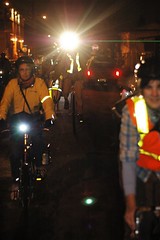Whether or not people should wear — or be mandated to wear — helmets is the bike world’s pro-choice/pro-life debate. From Europe to Australia and definitely here in the U.S., people are passionate about the topic and they cling adamantly to their positions. Personal anecdotes about a life saved due to a helmet are on one side and on the other side people simply don’t feel it’s neccessary and want to make their own choice.
Here in bike-centric Portland, it’s not unheard of to get called out by others in traffic for not wearing one. We have programs at local hospitals and events that give helmets out for free. Bike rodeos put on by police and fire stations always include helmet giveaways and our Bureau of Transportation measures helmet use in annual bike counts (but not light use).
Up in Vancouver (WA), former Mayor Royce Pollard helped push through an all-ages, mandatory helmet law. Back in 2008, an Oregon State Senator floated a similar idea, but backed down after massive push back.
I won’t be surprised if the issue comes up again in future legislative sessions.
With the dark season upon us here in Portland, I’ve been thinking… would it do more for safety if all (or more of) the pro-helmet energy was poured into bike light use? People riding bikes at night without lights is insane. It goes way beyond the whole, “don’t-tell-me-to-wear-bright-clothing” thing. Being a vehicle in traffic without lights other vehicles can see just makes no sense.
When I posed this thought to friends on Twitter, a lot of people seemed to agree. One of the folks who liked the idea was well-known advocate and author Kent Peterson from Seattle. He shared an informal study by bike safety expert David Smith that backs up my hunch.
Smith analyzed six fatal bike crashes in Seattle as well as data from the Washington State Traffic Safety Commission.
His findings were clear. Of the 10 adult fatalities, eight were at night, all involved a rider without a front light and in the four rear-end collisions (all at night) the rider did not have a rear reflector or light. Whether or not a helmet was worn did not factor as large as light use in the fatalities. Here’s an excerpt from Smith:
Only one adult cyclist out of five reported killed had a helmet. My observations are that helmet use is much more popular than consistently following traffic procedures or using lights at night. Perhaps 70 to 80% of cyclists use helmets. In this case the 20 to 30% of cyclists without helmets had 80% of the cycling deaths. Helmets have received much more attention than the utility of following the rules of the road and I often see cyclists being advised to “always wear a helmet” without any mention of traffic safety.
For me, the light issue isn’t just about community activism and doing more free bike light events, it’s about the bike industry. Here in the U.S., there are far too few bike companies that take real bike lights seriously. Walk into a shop and count how many bikes made for commuting and urban riding come with integrated front and rear lights. I bet in most shops you won’t find any at all.
Here in Portland, we’re lucky to have high awareness of bike light use. We’ve got the successful Get Lit program now run by the Community Cycling Center and tomorrow we’ve got a bike safety event by our regional transit agency that will include a “Most well lit” bike contest.
But despite these efforts, their are still many people riding “ninja” in the dark without lights. If we make this as big of an issue as we’ve made helmet use, I think we could have a significant impact on safety. It’s about a switch from crash mitigation to crash prevention.
Here are some questions to consider…
- Would we prevent more crashes and save more lives if the pro-helmet camp shifted some of that passion and energy to being pro-bike lights?
- Why has helmet use spurred so much debate and controversy, when bike lights barely get mentioned?
I’d love to hear your thoughts.


